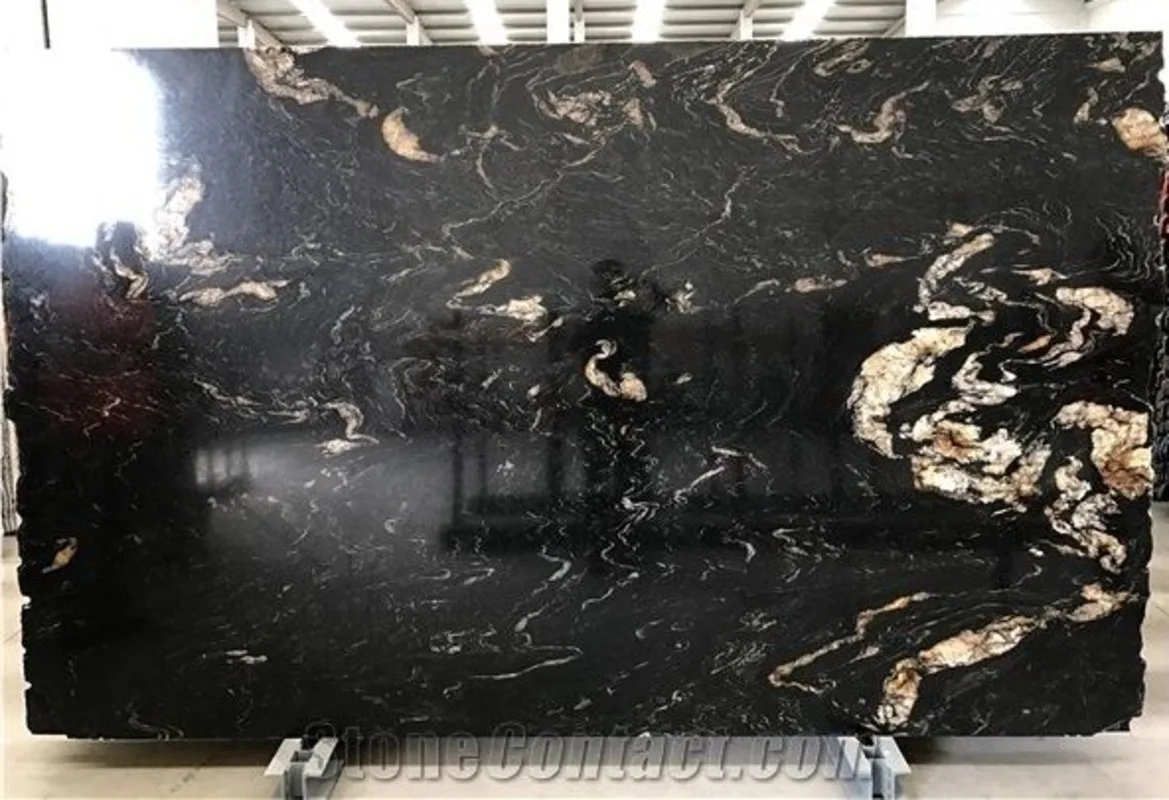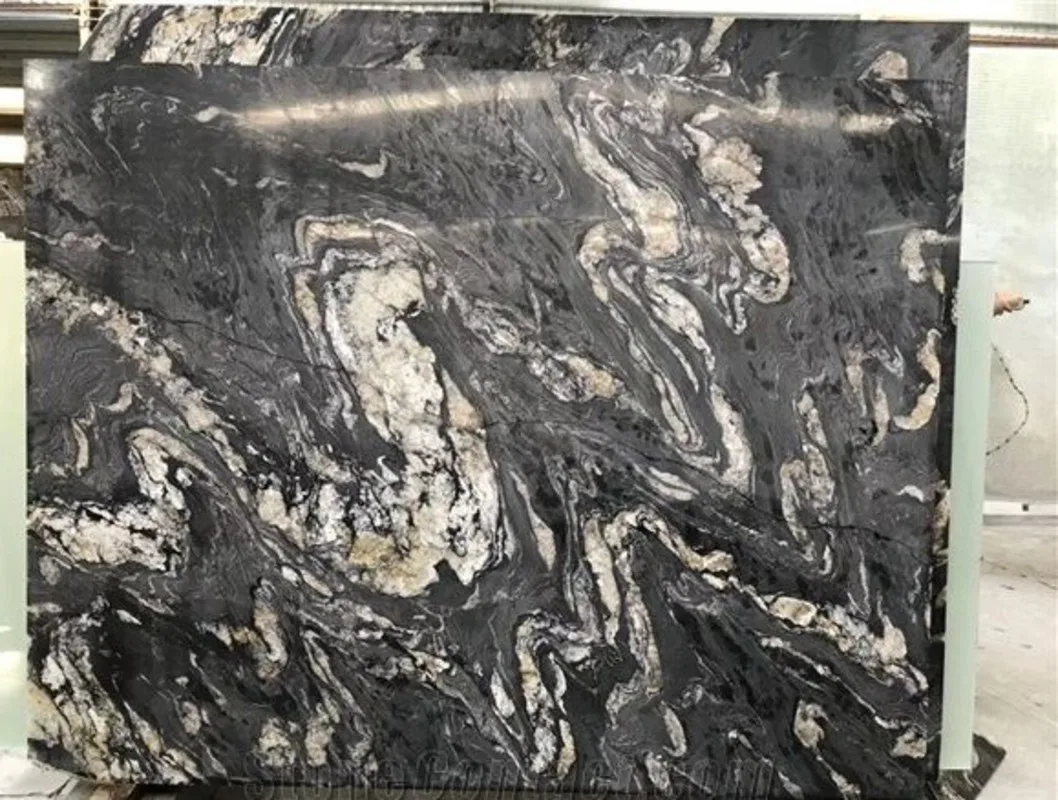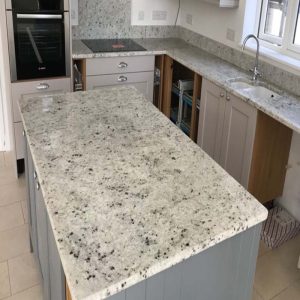Titanium Black Granite originates primarily from quarries in Brazil, renowned globally for abundant and high-quality granite deposits, with additional sourcing from Byawer district in Rajasthan, India. The Brazilian variety represents the original high-grade material, while the Indian variety from Rajasthan offers similar aesthetics with excellent performance characteristics from well-established quarries active since before the 1980s.
This igneous rock forms through slow cooling of molten magma deep beneath Earth’s surface, creating a dense, durable material composed primarily of quartz (35%), feldspar (45%), and potassium, with distinctive mica, quartzite, and biotite inclusions that contribute to the stone’s unique appearance. The black coloration results from high concentrations of biotite and hornblende minerals, while the lighter veining represents quartz and feldspar compositions that create the characteristic cosmic or galaxy-like pattern.
The stone’s dramatic visual impact makes it ideal for creating focal points in residential and commercial spaces. Architects and designers specify Titanium Black for luxury kitchen countertops where heat and scratch resistance are essential, bathroom vanity tops requiring stain resistance and moisture durability, commercial lobby flooring subject to high traffic, exterior building cladding, landscape paving features, fireplace surrounds, backsplashes creating visual continuity, and custom furniture applications including bar tops and table surfaces.
The bold contrast of bright white, cream, gold, and silver veining against the deep black background creates a cosmic or galaxy-like appearance that coordinates particularly well with contemporary, modern, and transitional design styles. The stone pairs effectively with white cabinets to create striking visual contrast, making the countertop a room’s focal point.
Performance and Quality
Titanium Black Granite demonstrates exceptional technical performance verified through industry testing. Brazilian material exhibits water absorption of just 0.00001%—significantly below the typical granite range of 0.05% to 0.40%—indicating extremely dense composition with virtually no porosity capable of harboring staining agents. This characteristic provides superior resistance to moisture penetration, staining, and bacterial retention compared to many countertop materials.
Compressive strength of 2,811 kg/cm² before freezing and 2,536 kg/cm² after freezing confirms suitability for structural applications and cold-climate installations. The ultimate tensile strength of 260 kg/cm² allows the material to resist bending and tension forces in cantilever configurations and spanning installations without failure.
Heat resistance extends to extremely high temperatures without cracking under normal use conditions. However, sudden extreme heat changes can potentially cause thermal shock, leading to cracks or damage. Users must employ trivets or hot pads for placing hot pans and cookware on countertops to prevent thermal gradients that might initiate cracking and to protect the sealer from heat damage.
While granite is generally robust and durable, black Titanium Granite can be more prone to scratches and etching compared to lighter-colored granites due to its mineral composition and surface characteristics. Dark-colored granite may show fingerprints and smudges more prominently than lighter varieties, requiring frequent cleaning to maintain visual appearance. The stone is not completely scratch-proof; avoid using sharp objects directly on the surface as they can potentially scratch or chip the countertop.
Materials and Construction
The unique composition of mica, quartzite, and biotite creates distinctive characteristics during fabrication. Because this stone includes areas with higher levels of quartz (harder than other minerals) and areas with softer minerals, it is normal that the edge shows a certain waving effect after fabrication. This characteristic waviness along cut edges is not a defect but rather a natural result of the stone’s varied mineral hardness and should be anticipated when planning installations requiring precise straight edges.
Color and grain structure variations can occur from block to block to a greater extent when compared to other similar materials due to natural geological formation processes. For large projects requiring visual consistency, specifying blocks from the same quarry face minimizes variation. Brazilian Titanium Granite can range from light to dark shades of grey and may contain varying concentrations of black or white flecks depending on the specific quarry source.
Parameter |
Description |
| Slab Sizes | Gang Saw Slabs: 280 x 180 CM up in 2, 3 CM, and other Cutter Slabs: 180 x 60 CM up in 2, 3 CM, and other |
| Tiles | 30×30, 30×60, 40×40, 60×40, 60×60, 60 x 90, 60×120 CM in various thicknesses and custom sizes |
| Thickness | 6 mm, 18 mm, 20 mm, 30 mm & custom options |
| Others | Window sills, thresholds, monuments, steps & treads, flagstones, & articles available in custom sizes |
| Finishes | Polished, honed, leathered, bush hammered, lepatora, flamed, shotblasted |
| Standard Thickness | 18 MM (other thicknesses available) |
| Place of Origin | North India |
Maintenance and Care
Titanium Black requires regular maintenance to preserve appearance and performance. Like all granite countertops, the material requires regular sealing to prevent staining and maintain luster. Failure to seal properly can result in permanent stains, particularly from highly pigmented fluids and oils to which the stone shows susceptibility. Apply quality impregnating sealer at least once annually for standard residential use; high-use kitchen and bathroom installations benefit from sealing every six months.
Daily cleaning requires only warm water and mild dish soap solution applied with soft cloth or microfiber mop. Avoid harsh cleaning products, abrasive cleaners, or chemicals containing acidic or alkaline properties that can remove the surface layer of sealer and in extreme cases damage the polished finish. Do not use vinegar, citrus-based products, or harsh chemical cleaners on the surface.
Address spills promptly to prevent potential staining. While the exceptionally low water absorption provides excellent stain resistance, prolonged exposure to wine, coffee, oils, and colored beverages can potentially penetrate if sealer has degraded. Wipe up spills immediately rather than allowing them to sit on the surface.
Expected service life for interior countertops ranges from 25 to 50+ years with proper maintenance and sealing. Flooring and exterior applications typically provide 50 to 100+ years of functional performance based on documented granite longevity in municipal infrastructure and architectural cladding applications.
Installation and Compatibility
Professional installation by experienced stone fabricators ensures optimal results and warranty coverage. Titanium Black’s density and mineral composition require specialized diamond tooling for all cutting, drilling, and edge-finishing operations. The material demands carbide-tipped or diamond-blade wet saws, CNC routing equipment for sink cutouts and edge profiles, and vacuum suction systems for safe slab handling.
For countertop installations, fabricators create precise template measurements, cut slabs to specification, polish edges to desired profile (accounting for natural edge waviness from varied mineral hardness), and install using appropriate adhesives rated for natural stone. Installation typically requires 1-3 days for standard residential kitchen configurations. The stone pairs effectively with white cabinets in sleek, simple designs that establish the dark granite countertop as the room’s focal point.
For flooring installations, use modified thin-set mortar specifically rated for natural stone over properly prepared substrate. Ensure substrate is level, stable, and appropriate for the weight load (approximately 12-13 lbs per square foot for 2cm thickness; 18-20 lbs per square foot for 3cm thickness). Grout selection affects final appearance—light grey or silver tones harmonize with the stone’s natural veining, while contrasting white emphasizes individual tile boundaries.
For outdoor applications, the material performs well in exterior kitchens, BBQs, and bars. Cover outdoor countertops during winter months in cold climates to protect sealer and minimize freeze-thaw exposure despite the stone’s documented cold-weather durability.
Pros & Cons
Advantages
- Exceptional stain resistance: Water absorption of 0.00001% (Brazilian) provides virtually impermeable surface resistant to moisture and staining agents
- Striking visual impact: Deep black with white-gold-silver veining creates dramatic cosmic/galaxy appearance suitable for focal point applications
- High structural strength: Compressive strength 2,811 kg/cm² and tensile strength 260 kg/cm² support demanding residential and commercial use
- Heat resistant: Withstands extremely high temperatures for cookware and outdoor applications when proper precautions (trivets) are used
Considerations
- Premium pricing: High-grade Brazilian material and distinctive appearance command higher cost than common grey or beige granites
- Shows fingerprints prominently: Dark surface reveals smudges, fingerprints, and water spots more visibly than lighter granite; requires frequent cleaning
- More scratch-prone than light granites: Dark varieties show scratches and etching more readily; cutting boards essential for food preparation
Who Should Buy
Ideal Buyers
- Luxury residential renovators seeking dramatic, focal-point countertop material with proven durability for high-end kitchen and bathroom projects
- Commercial designers specifying striking natural stone for hospitality lobbies, upscale restaurant bars, or corporate reception areas
- Modern/contemporary architects requiring bold visual statements in monochromatic or high-contrast design schemes
- High-end custom home builders needing distinctive natural stone that differentiates luxury properties in competitive markets
- Buyers appreciating natural variation who value unique cosmic patterns and understand edge waviness as authentic material characteristic
Not Recommended For
- Budget-conscious projects where cost is primary concern over aesthetics (consider less exotic granite varieties)
- Minimalist designs preferring uniform, no-variation surfaces without dramatic veining (consider Absolute Black or engineered materials)
- Buyers unwilling to maintain regular sealing schedule or accept fingerprint/smudge visibility on dark surfaces
- Projects requiring perfectly straight edges without any waviness from mineral hardness variation
- DIY installers without professional-grade diamond tooling and experience handling premium natural stone
Titanium Black Granite is also commonly known by the alternative names:
Absolute Black Granite, Black Titanium Granite, Titanium Noir Granite, Titanium Glod
FAQs
Q1: Is Brazilian Titanium Black Granite better than Indian Titanium Black?
Brazilian material represents the original high-grade variety with documented technical specifications (water absorption 0.00001%, compressive strength 2,811 kg/cm²) and commands premium pricing. Indian material from Rajasthan’s Byawer district offers similar aesthetics with excellent performance from established quarries. Both meet quality standards; choice depends on budget and availability.
Q2: How often should I seal Titanium Black Granite countertops?
Seal at least once annually for standard residential use. High-use kitchen and bathroom installations benefit from sealing every 6 months. Failure to maintain proper sealing schedule can result in permanent stains, particularly from oils and highly pigmented liquids. Test water absorption annually by placing water droplet; if it soaks in within 5 minutes, reseal immediately.
Q3: Why do my Titanium Black countertop edges look slightly wavy instead of perfectly straight?
This is a normal characteristic, not a defect. Titanium Black contains areas of harder quartz (Mohs 7) mixed with softer mica and biotite (Mohs 2.5-3). During cutting and polishing, diamond tools interact differently with these varying hardness zones, creating subtle edge waviness. Professional fabricators account for this inherent feature during installation.
Q4: Can I place hot pots directly on Titanium Black Granite countertops?
No. Although titanium granite is heat-resistant and can withstand extremely high temperatures, placing hot pots and pans directly on the surface may remove the sealer and potentially cause thermal shock cracking from sudden temperature changes. Always use trivets or hot pads for cookware from stovetops or ovens.
Q5: Why does my Titanium Black granite show fingerprints so prominently?
Dark-colored granite surfaces reveal fingerprints, smudges, and water spots more prominently than lighter varieties due to contrast against the black background. This is characteristic of all dark granite, not a quality issue. Clean frequently with warm water and mild dish soap to maintain appearance. Microfiber cloths prevent streaking.
Q6: Can Titanium Black Granite be used for outdoor kitchen countertops?
Yes. The material performs well in exterior kitchens, BBQs, and bars with proper maintenance. The low water absorption (0.00001% Brazilian) and high compressive strength support outdoor use. Cover countertops during winter months in cold climates to protect sealer. Ensure proper sealing before installation and maintain annual sealing schedule.









Reviews
There are no reviews yet.